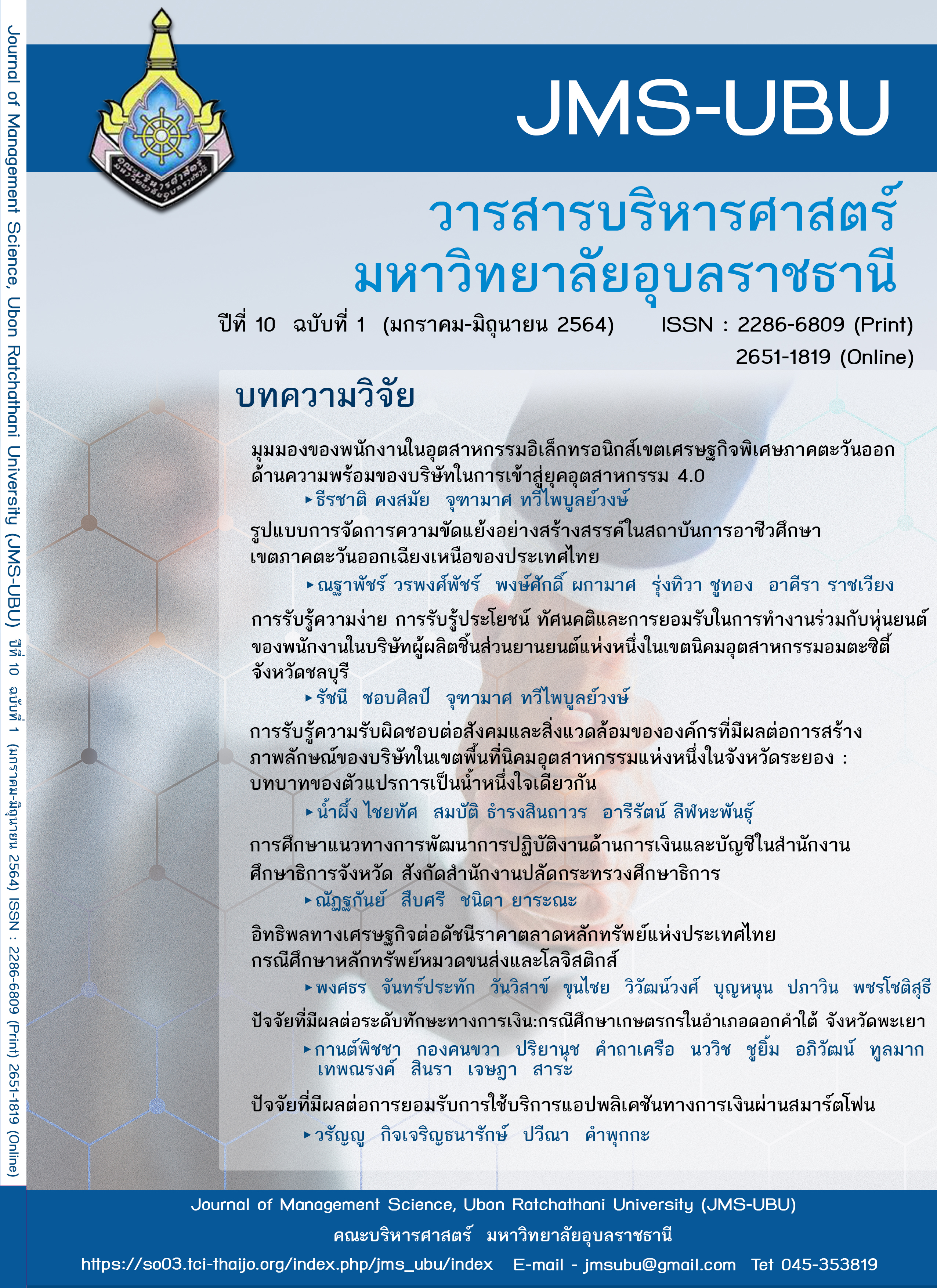ปัจจัยที่มีผลต่อการยอมรับการใช้บริการแอปพลิเคชันทางการเงินผ่านสมาร์ตโฟน
Main Article Content
บทคัดย่อ
การวิจัยครั้งนี้มีวัตถุประสงค์ (1) เพื่อเปรียบเทียบการยอมรับการใช้บริการแอปพลิเคชันทางการเงินผ่านสมาร์ตโฟนระหว่างผู้เคยใช้กับผู้ไม่เคยใช้บริการแอปพลิเคชันทางการเงินผ่านสมาร์ตโฟน (2) เพื่อศึกษาปัจจัยที่มีผลต่อการยอมรับการใช้บริการแอปพลิเคชันทางการเงินผ่านสมาร์ตโฟน กลุ่มตัวอย่าง คือ ผู้ที่เคยใช้และผู้ที่ไม่เคยใช้บริการแอปพลิเคชันทางการเงินผ่านสมาร์ทโฟนในประเทศไทยจำนวน อย่างละ 215 คน รวมเป็น 430 คน เครื่องมือที่ใช้ในการวิจัย คือ แบบสอบถาม มีค่าความเชื่อมั่นครอนบาคแอลฟา 0.870-0.900 สถิติที่ใช้ในการวิเคราะห์ข้อมูลได้แก่ สถิติเชิงพรรณนา สถิติการเปรียบเทียบ Man-Whitney U Test สหสัมพันธ์แบบเพียร์สัน และการวิเคราะห์ถดถอยเชิงพหุ ผลวิจัยพบว่า (1) กลุ่มเคยใช้บริการแอปพลิเคชันทางการเงินผ่านสมาร์ตโฟน มีค่ามัธยฐานของการยอมรับแอปพลิเคชันทางการเงินผ่านสมาร์ตโฟน มากกว่ากลุ่มผู้ไม่เคยใช้บริการแอปพลิเคชันทางการเงินผ่านสมาร์ตโฟน อย่างมีนัยสำคัญทางสถิติที่ระดับ 0.001 (2) การรับรู้การใช้งานง่าย การรับรู้ถึงประโยชน์ การรับรู้ความเสี่ยง และการรับรู้ผลลัพธ์ มีผลต่อการยอมรับการใช้บริการแอปพลิเคชันทางการเงินผ่านสมาร์ตโฟน อย่างมีนัยสำคัญทางสถิติที่ระดับ 0.001 โดยสามารถอธิบายการเปลี่ยนแปลงของการยอมรับการใช้บริการแอปพลิเคชันทางการเงินผ่านสมาร์ตโฟน ได้ร้อยละ 51.8
Downloads
Article Details
บทความที่ตีพิมพ์ในวารสารบริหารศาสตร์ มหาวิทยาลัยอุบลราชธานี เป็นลิขสิทธิ์ของวารสาร โดยเนื้อหาและความคิดเห็นในบทความเป็นความรับผิดชอบของผู้เขียนแต่ละท่าน ไม่เกี่ยวข้องกับคณะบริหารศาสตร์ มหาวิทยาลัยอุบลราชธานีแต่อย่างใด และหากมีข้อผิดพลาดประการใด ผู้เขียนจะเป็นผู้รับผิดชอบต่อบทความของตนเองแต่เพียงผู้เดียว
เอกสารอ้างอิง
จิญาดา แก้วแทน. (2557). ปัจจัยที่มีผลต่อการยอมรับการใช้บริการชำระเงินอิเล็กทรอนิกส์ผ่านอุปกรณ์สมาร์ตโฟน: กรณีศึกษาในพื้นที่กรุงเทพมหานครและปทุมธานี. (การค้นคว้าอิสระปริญญามหาบัณฑิต). มหาวิทยาลัยเทคโนโลยีราชมงคลธัญบุรี, คณะบริหารธุรกิจ.
ปวีณา คำพุกกะ. (2557). สถิติธุรกิจ. อุบลราชธานี : พิมพลักษณ์.
ภัทรา มหามงคล. (2554). ปัจจัยที่มีผลต่อการตัดสินใจเลือกใช้บริการธนาคารทางโทรศัพท์มือถือของธนาคารกสิกรไทย จํากัด (มหาชน) ในกรุงเทพมหานคร. (การศึกษาเฉพาะบุคคลปริญญามหาบัณฑิต). มหาวิทยาลัยกรุงเทพ.
ฤทธิชัย เจริญผ่อง. (2556). พัฒนาการโทรศัพท์มือถือก่อนจะเป็นสมาร์ทโฟน ในรูปแบบ Infographic. สืบค้นเมื่อ 15 มีนาคม 2562, จาก http://y34.wikidot.com/it-report01-050
สิงหะ ฉวีสุข และ สุนันทา วงศ์จตุรภัทร. (2555). ทฤษฎีการยอมรับการใช้เทคโนโลยีสารสนเทศ. KMITL Information Technology Journal. 1(1), สืบค้นเมื่อ 21 ธันวาคม 2562 จาก http://www.it.kmitl.ac.th/~journal/index.php/main_journal/article/view/2
Bandura, A., O'Leary, A., Taylor, C. B., Gauthier, J., & Gossard, D. (1987). Perceived self-efficacy and pain control: Opioid and nonopioid mechanisms. Journal of Personality and Social Psychology, 53(3), 563-571.
Chanchai Phonthanukitithaworn, Sellitto C., Fong, W. L. (2016). A comparative study of current and potential users of mobile payment services. SAGE Open Journals, 6(4), 1-14.
El-Gohary, H., (2012). Factors affecting e-marketing adoption and implementation in tourism firms : An empirical investigation of Egyptian small tourism organisations. Tourism Management, 33(5), 1256-1269.
Lee, M.C. (2009). Factors influencing the adoption of internet banking: An integration of TAM and TPB with perceived risk and perceived benefit. Electronic Commerce Research and Applications, 8(3), 130-141.
Lule. I., Omwansa, T., & Mwololo, T. (2012). Application of technology acceptance model (TAM) in M-banking adoption in Kenya. International Journal of Computing and ICT Research, 6(1), 31-43.
Maduku, D. K. (2014). Behavioral intention towards mobile banking usage by South African retail banking clients. Investment Management and Financial Innovations, 11(3), 37-51.
Nair, R. S., & Fasal, S. (2017). Mobile banking and its adopting challenges. International Journal of Computer Applications, 160(4), 24-30.
Oliveira, T. Thomas, M., Baptista, G. & Campos, F. (2016). Mobile payment: Understanding the determinants of customer adoption and intention to recommend the technology. Computers in Human Behavior, 61, 404-414.
P.B. (2019, September 12) คนไทยขึ้นแท่นแชมป์โลก สัดส่วนผู้ใช้บริการ Mobile Banking สูงสุด 74% ของผู้ใช้อินเทอร์เน็ตทั่วประเทศ, Droidsans. สืบค้นจาก https://droidsans.com/thailand-mobile-banking-2019-to-cashless-society
Proença J. F., & Rodrigues M. A. (2011). A comparison of users and non-users of banking self-service technology in Portugal. Journal of Service Theory and Practice, 21(2), 192-210.
Yamane, T. (1973). Statistics. An Introductory Analysis (3rd ed.). New York: Harper and Row.
Yi, M. Y., & Hwang, Y. (2003). Predicting the use of web-based information systems : Self-efficacy, enjoyment, learning goal orientation, and the technology acceptance model. International Journal of Human-Computer Studies, 59(4), 431-449.
Zhou, T. (2011). The effect of initial trust on user adoption of mobile payment. Information Development, 27(4), 290-300.

